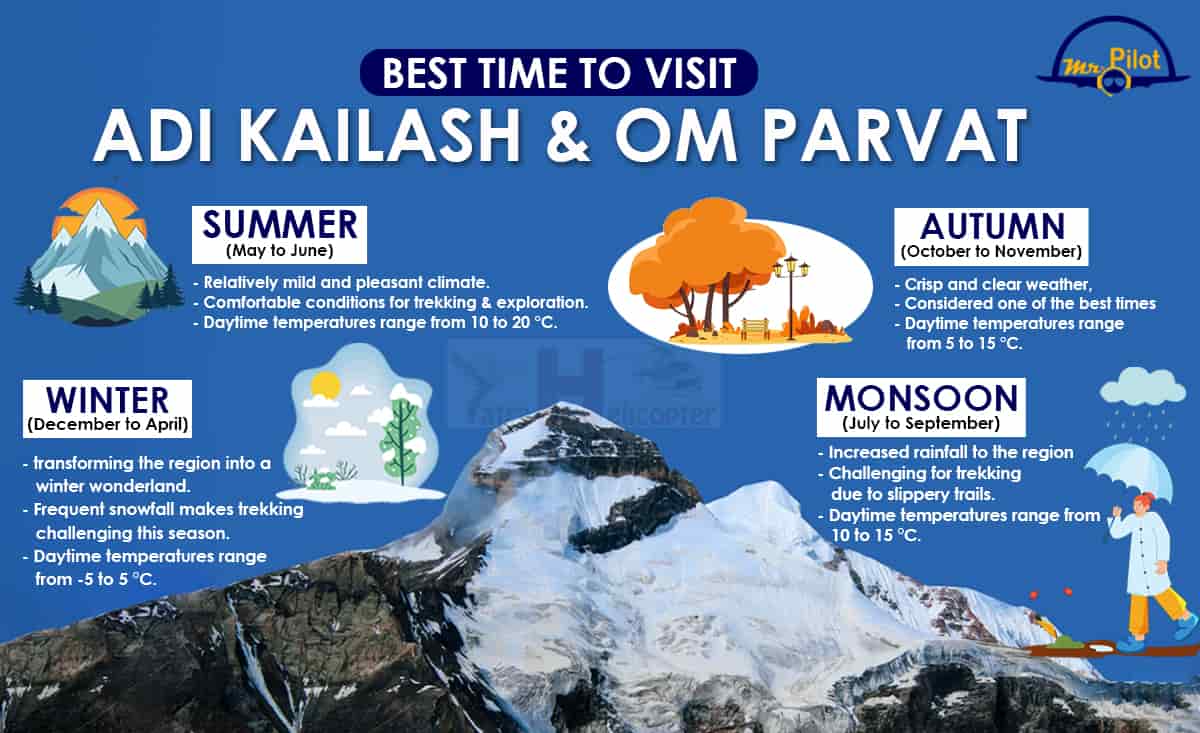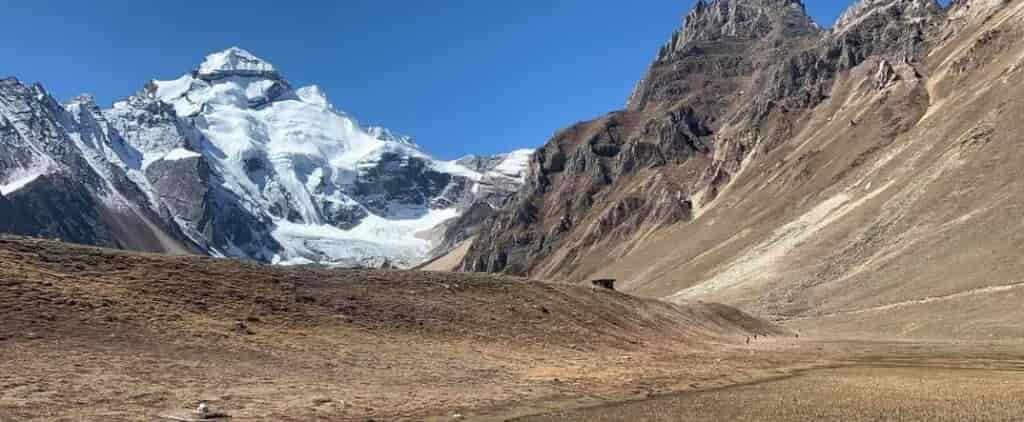Last Updated on October 26, 2024
Adi Kailash, also known as Baba Kailash, is a significant pilgrimage site that attracts devotees and trekkers alike, all drawn by its spiritual essence and breathtaking landscapes. Nestled in the Himalayas, it offers an unparalleled experience of nature, culture, and spirituality. Om Parvat, located nearby, adds to the allure of this region, especially with its unique snow formation resembling the sacred “Om” symbol. However, the weather in this area varies significantly throughout the year, making it crucial for travelers to plan their visit during the best season. This guide delves into the best times to visit Adi Kailash and Om Parvat, detailing the temperatures, weather conditions, and seasonal considerations. 
Overview of Seasons in Adi Kailash and Om Parvat
Adi Kailash and Om Parvat are renowned destinations nestled in the majestic Himalayas, attracting pilgrims and trekkers with their stunning landscapes and spiritual significance. Understanding the seasonal variations in weather and temperature is essential for planning a visit. Here’s a detailed overview of the seasons in this region:
1. Summer Season/Grishma Ritu (Late April to June)
- Temperature: Daytime temperatures range from 19°C to 25°C, while night time lows can drop to around -2°C to 21°C.
- Weather Conditions: This is the most favourable time to visit, with clear skies and minimal rainfall. The melting snow reveals well-defined trekking paths.
Highlights:
- Ideal conditions for trekking to both Adi Kailash and Om Parvat.
- Rich flora and breath-taking views of the surrounding landscapes.
- Lower risk of landslides makes travel safer.
Why Visit?
- Ideal Trekking Conditions: The snow from the previous winter has melted, revealing well-defined trails, making the treks to both Adi Kailash and Om Parvat more accessible.
- Less Risk of Landslides: The stability of the terrain during this period significantly reduces the risk of landslides, which can be a concern in hilly areas.
- Natural Beauty: The surrounding flora comes to life, and the scenery is picturesque, providing stunning views of the Himalayas and the iconic Om Parvat.
What to Pack?
Travelers are advised to carry warm clothing for chilly nights, along with essentials like trekking gear, sunscreen, and a hat to protect against the sun.

2. Monsoon Season/Rainy Season(July to August)
- Temperature: Daytime temperatures hover around 20°C, with night-time lows of 6°C.
- Weather Conditions: Heavy rainfall characterizes this period, leading to muddy and slippery trails. Visibility may also be poor.
Challenges:
- Increased risk of landslides and road blockages.
- Difficult trekking conditions; caution is advised for travellers.
- Cultural Significance: This period is considered holy, attracting many pilgrims despite the weather challenges.
Considerations for Travel
- Travel Cautions: While many pilgrims still undertake the yatra during this auspicious time (especially during the holy month of Sawan), caution is paramount due to the risk of landslides and road blockages.
- Difficult Conditions: The heavy rainfall can lead to poor visibility and difficult trekking conditions. Travelers should be prepared for delays and carry extra provisions.
Also Read: How to Reach Adi Kailash
What to Pack?
Waterproof clothing, sturdy footwear, and additional safety gear are crucial. It’s also wise to have a flexible itinerary to accommodate potential disruptions.
3. Post-Monsoon / Autumn Season (September to Mid-October)
- Temperature: Daytime temperatures are around 20°C, dropping to about 4°C at night.
- Weather Conditions: The weather becomes stable, with clear skies and crisp air, making it another excellent time for trekking and pilgrimage.
Highlights:
- Lush landscapes enhanced by monsoon rains.
- Stunning views of the snow-capped Om Parvat.
- Less crowded compared to the summer months, offering a serene experience.
Why Visit?
- Stunning Scenery: The monsoon rains leave the landscape lush and vibrant, enhancing the natural beauty of the region. The views of the Himalayas and the snow-capped Om Parvat become particularly breathtaking.
- Less Crowded: Compared to the summer months, this season tends to see fewer tourists, allowing for a more serene and personal experience during the yatra.
- Spiritual Experience: The post-monsoon period is seen as a spiritually enriching time, making it a favored choice for many pilgrims.
What to Pack?
Light woolens are advisable for chilly nights, alongside regular trekking gear. It’s also beneficial to carry hydration supplies and snacks for long treks.
4. Winter Season/ Shishir or Shita Ritu (November to April)
- Temperature: Daytime temperatures range from -6°C to 16°C, with nighttime lows often reaching -30°C.
- Weather Conditions: Extremely cold with heavy snowfall can lead to road closures and unsafe travel conditions.
Challenges:
- Travel is generally not advisable during this period due to severe weather.
- The presence of black ice makes navigation perilous.
Considerations for Travel
- Travel Restrictions: Due to severe weather conditions, travel to Adi Kailash and Om Parvat is generally not advisable during this period. The government often closes access routes to ensure traveler safety.
- Challenging Conditions: The presence of black ice on roads makes it perilous to navigate, and the cold winds can be unbearable.
What to Pack ? (if traveling before mid-October)
While trekking in the earlier part of this season, warm, insulated clothing, sturdy boots, and essential survival gear are necessary. However, it is highly recommended to complete any travels before mid-October to avoid the onset of heavy snowfall.

Conclusion
The Adi Kailash and Om Parvat Yatra is not just a pilgrimage; it is a journey through breathtaking landscapes and profound spirituality. Choosing the right time to visit is crucial for a fulfilling experience. The summer months and post-monsoon season are your best bets for comfortable weather and safe trekking conditions. Remember to stay informed about local weather updates and prepare adequately for the specific season you choose to visit. With the right planning, the journey to Adi Kailash and Om Parvat can be an unforgettable adventure, filled with beauty, spirituality, and the awe of nature.



